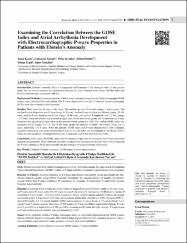| dc.contributor.author | Kasar, Taner | |
| dc.contributor.author | Tanıdır, Cansaran | |
| dc.contributor.author | Ayyıldız, Pelin | |
| dc.contributor.author | Öztürk, Erkut | |
| dc.contributor.author | Ergül, Yakup | |
| dc.contributor.author | Güzeltaş, Alper | |
| dc.date.accessioned | 2023-11-16T13:09:34Z | |
| dc.date.available | 2023-11-16T13:09:34Z | |
| dc.date.issued | 2019 | en_US |
| dc.identifier.issn | 2149-2972 | |
| dc.identifier.issn | 2149-2980 | |
| dc.identifier.uri | https://hdl.handle.net/11363/6411 | |
| dc.description.abstract | Introduction: Ebstein’s anomaly (EA) is a congenital malformation of the tricuspid valve. In the present
study, the aim was to examine the relationship between the Great Ormond Street Score (GOSE) index and
P-wave characteristics in patients with EA.
Patients and Methods: Unoperated patients with EA were evaluated retrospectively. Echocardiographic GOSE
indices were calculated for each patient. The P-wave characteristics on the 12-channel electrocardiography
(ECG) were also evaluated simultaneously.
Results: There were EA 24 cases in the study. The median age was 12 months (range, 1 day-8 years). The
median P-wave dispersion was 18 msn (range, 8-36 msn), median P-max duration was 86 msn (range, 58-104
msn), median P-min duration was 62 ms (range, 18-88 msn), and median P amplitude was 2.7 mm (range,
1.2-5 mm). Atrial arrhythmia was detected in eight cases. In the arrhythmia group, the P dispersion and P-max
duration were significantly higher than in the non-arrhythmic group (p< 0.05). The median GOSE index was
measured as 0.62 (range, 0.2-1.3). The GOSE index grade was detected as Grade 1 in 8 cases, Grade 2 in 12
cases, and Grade 3 in 4 cases. When the patients’ GOSE index and P-wave characteristics were evaluated,
a positive correlation was found between the P-max (r= 0.5, p= 0.02) and P amplitude (r= 0.780, p= 0.001).
There was no significant correlation between the P dispersion and P-min durations (p> 0.05).
Conclusion: In EA cases, the GOSE index can be estimated, especially by evaluating the P-wave maximum
duration and amplitude. Thus, clinicians may have an idea about the prognosis of cases with EA by evaluating
the P-wave changes in ECG and especially the development of supraventricular arrhythmia. | en_US |
| dc.description.abstract | Giriş: Ebstein anomalisi (EA) triküspit kapağın konjenital bir malformasyonudur. Bu çalışmada EA’lı olgularda
“Great Ormond Street Score (GOSE)” indeksi ile P dalga özellikleri arasındaki ilişkinin incelenmesi amaçlandı.
Hastalar ve Yöntem: Ameliyat olmamış ve EA tanısı alan olgular retrospektif olarak değerlendirildi. Hastaların ekokardiyografik olarak GOSE indeksleri hesaplandı. Eş zamanlı çekilen 12 kanallı elektrokardiyografi (EKG)’deki P dalga özellikleri (P maksimum, P minimum, P dispersiyon, P amplitüdü) ölçüldü.
Sonuçlar değerlendirildi.
Bulgular: Çalışmada EA’lı 24 olgu mevcuttu. Ortanca P dalga dispersiyonu 18 msn (aralık: 8-36 msn), ortanca P-maks süresi 86 msn (aralık: 58-104 msn), ortanca P-min süresi 62 msn (aralık: 18-88 msn) ve ortanca P
amplitüdü 2.7 mm (aralık: 1.2-5 mm) olarak hesaplandı. Atriyal aritmi 8 olguda saptandı. Aritmisi olan grupta
nonaritmik grupta P dispersiyon ve P-maks süresi anlamlı olarak daha yüksekti (p< 0.05). Ortanca GOSE indeksi 0.62 (aralık: 0.2-1.3) olarak ölçüldü. GOSE indeksi derecesi 8 olguda Grade 1; 12 olguda Grade 2 ve 4
olguda Grade 3 olarak saptandı. Hastaların GOSE indeksi ile P dalga özellikleri değerlendirildiğinde; P-maks
(r= 0.5, p= 0.02) ve p amplitüdü (r= 0.780, p= 0.001) arasında pozitif yönde bir ilişki saptandı. P dispersiyonu
ve P-min süreleri arasında anlamlı ilişki gözlenmedi (p> 0.05).
Sonuç: EA’lı olgularda özellikle P dalga maksimum süresi ve amplitüdü değerlendirilerek GOSE indeksi
tahmin edilebilir. Böylece klinisyenler EKG’deki P dalga değişiklikleri ile EA’lı olguların prognozu hakkında ve özellikle supraventriküler aritmi gelişimi yönünden fikir sahibi olabilirler. | en_US |
| dc.language.iso | eng | en_US |
| dc.publisher | Kartal Koşuyolu Yüksek İhtisas EAH | en_US |
| dc.relation.isversionof | 10.5578/khj.67595 | en_US |
| dc.rights | info:eu-repo/semantics/openAccess | en_US |
| dc.rights | Attribution-NonCommercial-NoDerivs 3.0 United States | * |
| dc.rights.uri | http://creativecommons.org/licenses/by-nc-nd/3.0/us/ | * |
| dc.subject | Children | en_US |
| dc.subject | Ebstein’s anomaly | en_US |
| dc.subject | GOSE index | en_US |
| dc.subject | P-wave characteristics | en_US |
| dc.subject | Çocuk | en_US |
| dc.subject | Ebstein anomalisi | en_US |
| dc.subject | GOSE indeksi | en_US |
| dc.subject | P dalga özellikleri | en_US |
| dc.title | Examining the Correlation Between the GOSE Index and Atrial Arrhythmia Development with Electrocardiographic P-wave Properties in Patients with Ebstein’s Anomaly | en_US |
| dc.title.alternative | Ebstein Anomalili Hastalarda Elektrokardiyografik P Dalga Özellikleri ile “GOSE İndeksi” ve Atriyal Aritmi Gelişmesi Arasında Korelasyon Var mı? | en_US |
| dc.type | article | en_US |
| dc.relation.ispartof | Koşuyolu Heart Journal | en_US |
| dc.department | Sağlık Hizmetleri Meslek Yüksekokulu | en_US |
| dc.authorid | https://orcid.org/0000-0002-1811-3658 | en_US |
| dc.authorid | https://orcid.org/0000-0002-1762-3269 | en_US |
| dc.authorid | https://orcid.org/0000-0001-8814-0435 | en_US |
| dc.identifier.volume | 22 | en_US |
| dc.identifier.issue | 1 | en_US |
| dc.identifier.startpage | 7 | en_US |
| dc.identifier.endpage | 12 | en_US |
| dc.relation.publicationcategory | Makale - Ulusal Hakemli Dergi - Kurum Öğretim Elemanı | en_US |
| dc.institutionauthor | Öztürk, Erkut | |



















